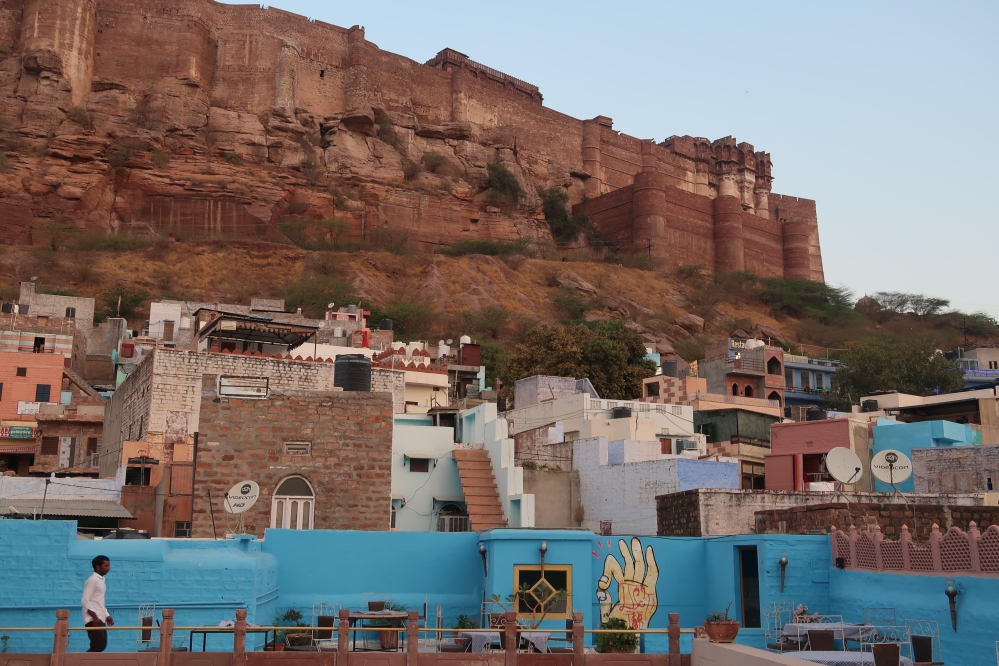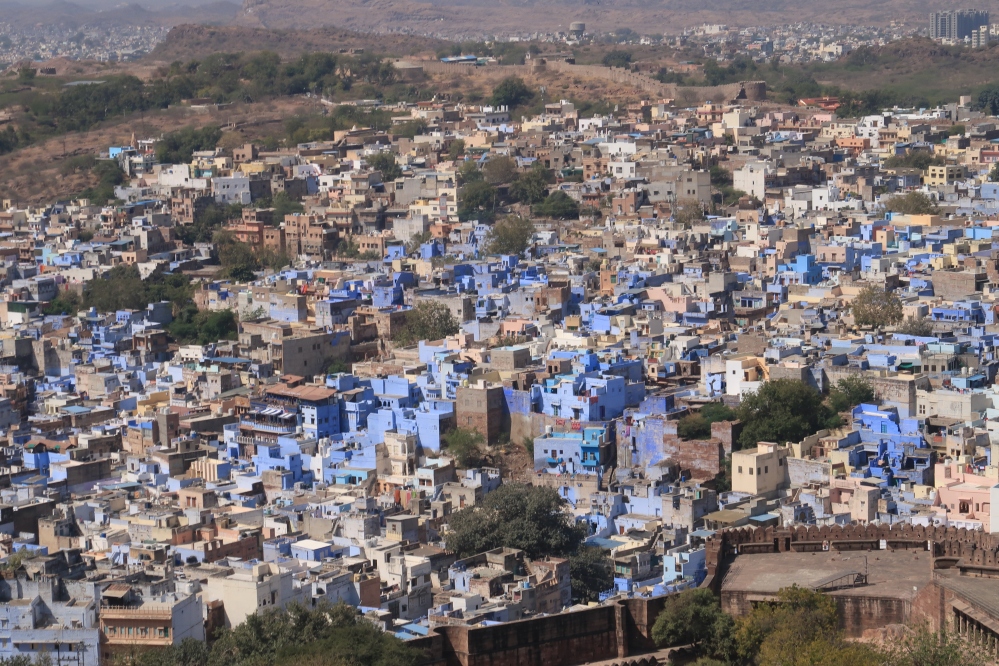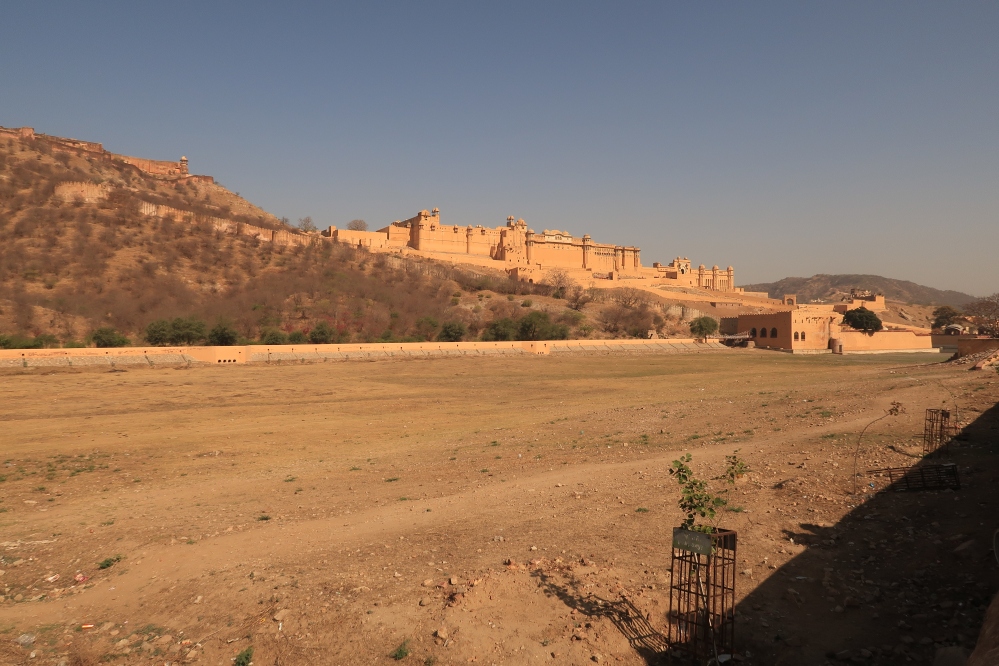When I describe my trip to Rajasthan, I find that I can only do so in terms of colour. Not just the colours of the women’s saris or the colours of the markets or of the birds and flowers, but of the cities and landmarks themselves.
In Delhi (not actually in Rajasthan, but that’s where I flew into), there is the Red Fort. It is quit red indeed, built from red sandstone which was burnished in the March sunshine.  I didn’t go in – my guide book said that the British army had destroyed much of the original building, a fact confirmed by a chatty young man from Chile whom I met outside. I was aware, I suppose, that there were a lot of forts in India in general, but I must admit that I had never given much thought of who might have built them. I had a vague idea that the British army might have built some of them, a way to control the country. I suspect that much of this idea came from the forts that the same army built in Scotland to control the people in the 18th century – Fort William, Fort Agustus, Fort George. But, of course, there were wars and fighting long before this in India (and in Scotland), and the forts of Rajasthan (and Delhi) were built in earlier centuries by a variety of kings and warriors.
I didn’t go in – my guide book said that the British army had destroyed much of the original building, a fact confirmed by a chatty young man from Chile whom I met outside. I was aware, I suppose, that there were a lot of forts in India in general, but I must admit that I had never given much thought of who might have built them. I had a vague idea that the British army might have built some of them, a way to control the country. I suspect that much of this idea came from the forts that the same army built in Scotland to control the people in the 18th century – Fort William, Fort Agustus, Fort George. But, of course, there were wars and fighting long before this in India (and in Scotland), and the forts of Rajasthan (and Delhi) were built in earlier centuries by a variety of kings and warriors.
Bikaner also has a fort – Junagarth Fort – whose walls were just as red as those of the fort in Delhi. Again, this was all that I saw as we arrived to late to visit inside, and left before it opened the next day.
Thankfully Jaiselmer did not disappoint. Not only does it have a magnificent fort perched on a hill on the edge of the mighty Thar desert, but it is known as the Golden City.

In the sun of the morning and late afternoon it did indeed glow golden, the pale yellow sandstone capturing the warmth of the desert. Behind the golden walls were temples and palaces, shops and courtyards.
Walls were painted with bright murals to celebrate weddings. The inside of the palaces were sumptuous with mirrors and painted wood. A steep cobbled road led to the fort through a series of ‘elephant proof’ doors – large spikes sticking out at elephant head height to discourage a charging war elephant even if it could pick up enough speed charging up the steep hill.
Jodhpur is known as the Blue City – and when you look online at photos it does appear as if the Mehrangarh Fort is indeed floating on a sea of blue houses.

But if you wander around the streets, it takes a while to reach the blue house area, which is actually quite small. Pretty but small.

The fort itself is pretty spectacular, with exhibitions and displays of turban-wrapping, hookah smoking and a palm reader. Wandering around with an audio guide is a relaxing way to see and understand a little of the history of the place.
Jaipur is just greedy when it comes to claiming colours for itself. The city itself is known as the Pink City – the old walled part is painted a very particular shade of deep pink, but this custom (now a law) only goes back around 100 years when there was a visit by the then British Prince of Wales.

It’s a wild ride forcing your way through the hectic streets of vendors and shops – tea, jewellery, clothes, perfume, paint for Holi, vegetables…. There is a shop for everything, and even a library.
Just outside the city is the Amber Fort, another vast structure on a hill, which is neither golden nor red, but somewhere inbetween.

The views from below are just as amazing as the views inside the fort. There is another steep climb – and I urge you to climb on your own two feet and not to use the poor elephants who toil up and down the hard cobles in the heat in an endless line. It was hard to watch the poor animals being used in an environment so alien from their natural habitat. They looked weary and dispirited – you don’t need to take one! Rather, admire the many carved elephants inside the fort, dedicated to the god Ganesh.




